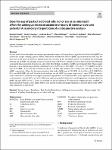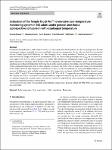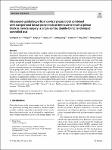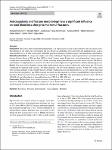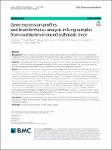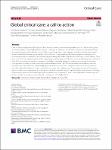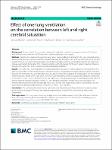Search
Author
- Daqing, Ma (3)
- Alexis, Ferré (2)
- Anna, Lybeck (2)
- Ashish K., Khanna (2)
- next >
Subject
- intensive care unit (8)
- acute respiratory dist... (5)
- chronic obstructive pu... (5)
- ICU (5)
- next >
Has File(s)
Search Results
In vitro studies have thoroughly documented age-dependent impact of storage lesions in packed red blood cells (pRBC) on erythrocyte oxygen carrying capacity. While studies have examined the effect of pRBC age on patient outcome only few data exist on the microcirculation as their primary site of action. In this secondary analysis we examined the relationship between age of pRBC and changes of microcirculatory flow (MCF) in 54 patients based on data from the Basel Bedside assessment Microcirculation Transfusion Limit study (Ba2MiTraL) on effects of pRBC on sublingual MCF. |
Perioperative hypothermia is still common and has relevant complication for the patient. An effective perioperative thermal management requires essentially an accurate method to measure core temperature. So far, only one study has investigated the new Temple Touch Pro™ (Medisim Ltd., Beit-Shemesh, Israel). during anesthesia Therefore, we assessed the agreement between the Temple Touch Pro™ thermometer (TTP) and distal esophageal temperature (TEso) in a second study. After approval by the local ethics committee we studied 100 adult patients undergoing surgery with general anesthesia. |
The sensory innervation of the clavicle is complex, and the best regional block technology for clavicular surgery has yet to be determined. The purpose of this study was to compare the application of ultrasound-guided superficial cervical plexus block combined with clavipectoral fascial plane block verses interscalene brachial plexus block in clavicular surgery. Fifty patients undergoing internal fixation surgery for elective clavicle fractures were randomly divided into two groups (n = 25 for each group): group I and group II. |
Blood loss after proximal femoral fractures is an important risk factor for postoperative outcome and recovery. The purpose of our study was to investigate the total blood loss depending on fracture type and additional risks, such as anticoagulant use, to be able to recognize vulnerable patients depending on planned surgery and underlying comorbidities. |
Shrinking Man syndrome (SMS) is a rare but often serious complication of dialysis-dependent end-stage renal disease, characterized by significant loss of height, bone pain, bone deformity, and skin itching. Patients with SMS always have abnormal facial changes and cardiovascular system damage (manifested by hypertension, hypotension, cardiovascular calcification, and valvular heart disease), which pose a great challenge to anaesthesiologists. The purpose of this report is to describe our anaesthetic experience regarding two patients with SMS combined with alterations of the airway and cardiovascular system. |
This paper describes the development and implementation of an anesthesia data warehouse in the Lille University Hospital. We share the lessons learned from a ten-year project and provide guidance for the implementation of such a project. Our clinical data warehouse is mainly fed with data collected by the anesthesia information management system and hospital discharge reports. The data warehouse stores historical and accurate data with an accuracy level of the day for administrative data, and of the second for monitoring data. |
Asthma is characterized by chronic inflammation and airway remodeling. However, limited study is conducted on the gene expression profiles of ovalbumin (OVA) induced asthma in mice. Here, we explored the gene expression profiles in lung tissues from mice with OVA-induced asthma using microarray and bioinformatics analysis. |
Critical care is underprioritized. A global call to action is needed to increase equitable access to care and the quality of care provided to critically ill patients. Current challenges to effective critical care in resource-constrained settings are many. Estimates of the burden of critical illness are extrapolated from common etiologies, but the true burden remains ill-defined. Measuring the burden of critical illness is epidemiologically challenging but is thought to be increasing. Resources, infrastructure, and training are inadequate. Millions die unnecessarily due to critical illness. |
To preliminary evaluate the application of novel SaCoVLM video laryngeal mask -guided intubation for anesthetized children. |
To investigate if the correlation between left and right cerebral tissue oxygen saturation (SctO2) was affected by one-lung ventilation (OLV) in patients undergoing lung cancer surgery. |

